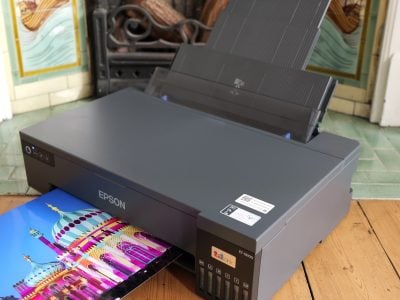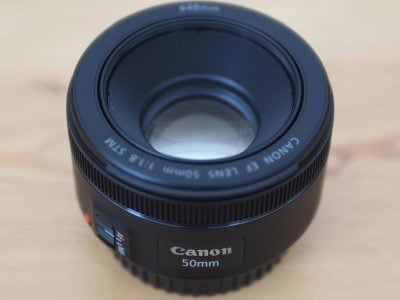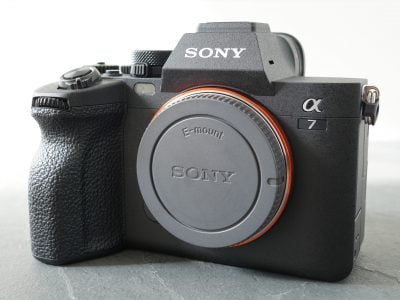Sony Cyber-shot DSC-H9
-
-
Written by Gordon Laing
Sony Cyber-shot DSC-H9 design and build quality
The Sony Cyber-shot DSC-H9 is a compact super-zoom camera that’s styled to look like DSLR, albeit much smaller and lighter in practice. We’ve pictured it below flanked by the Panasonic Lumix FZ8 and Canon EOS 400D / XTi and it’s clear that while the FZ8 is even smaller still, both super-zooms are noticeably smaller than the ‘genuine’ DSLR on the right.
Viewed from the front, the H9 closely resembles the design of its predecessor the H5, although there are a number of differences which become obvious when both models are placed side by side. For example the H9 is a little smaller overall, missing the H5’s front finger wheel and has a slightly more pronounced indentation for your middle finger. There is of course an even bigger difference round the back, but we’ll come to that in our Features section.
The overall build quality is very good and the H9 comfortable to hold, although we feel the Olympus SP-550UZ has the edge in both comfort and build. It’s a personal thing though, so you should pick the camera up for yourself to see how well it fits in your hand. Unlike the Olympus SP-550UZ, there’s no underwater option for the H9.
Sony Cyber-shot DSC-H9 controls
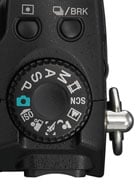 |
Like other super-zooms, the Sony H9 features an SLR-style command dial on its upper right surface; this offers the usual Auto, Program, Manual, Aperture and Shutter Priority modes, along with direct access to five scene presets, a programmable SCN position which offers the choice of four additional scenes, and finally the H9’s Movie mode.
Joining the command dial are a decent shutter release and large power button, along with two smaller buttons to adjust the metering mode and continuous shooting and bracketing options – more of which later.
The main controls round the back are centred on the usual four-way rocker button. Pushing up switches between the different display modes, pushing right changes the flash options, pushing down activates the self-timer, and pushing left sets the macro mode for close-up shooting. Above and below this are the Menu and Home buttons which present further options for the current shooting mode, including access to the quality and image processing settings.
Surrounding the rocker is a rotary thumb wheel which is used in conjunction with a button in the middle to select, then adjust various settings like the ISO, aperture, shutter speed, exposure compensation and focusing areas.
When using the H9 you’ll notice one of the settings running along the bottom of the screen is highlighted in yellow with a white triangle above it – this highlighted setting can be adjusted straightaway by turning the wheel, and the H9 sensibly defaults to the most relevant setting in each mode. For example in Aperture Priority, the f-number is highlighted in yellow and therefore ready for instant adjustment. In Program mode, both the aperture and shutter value are highlighted and adjusted together as you’d expect – see screen shot.
Pressing the centre button highlights the triangle, allowing you to use the dial to then position it above the desired setting, such as the ISO or exposure compensation. Pressing the centre button again highlights the setting under the triangle, allowing you to subsequently adjust it. We’ve got more details on its operation in our Features section along with a full demonstration in our H9 video tour.
In a nice touch, Sony also includes a small infra-red remote control with the H9, which allows you to zoom the lens, fire the shutter, navigate the menus and start a slideshow. It’s a handy accessory and a generous inclusion here.
Sony Cyber-shot DSC-H9 metering and exposures
The Sony Cyber-shot H9 has a dedicated button for metering on its top surface and it allows you to switch between Spot, Center-weighted and Multi-pattern metering modes, the latter taking the entire frame into account. We used the latter for all our sample and gallery shots and found it did a good job of evaluating most scenes with only occasional need for exposure compensation.
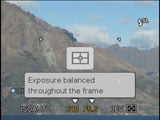 |
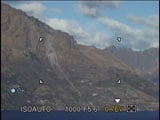 |
The H9 offers shutter speeds from 1/4000 to 30 seconds, although for shutter speeds faster than 1/2000, you’ll need to be using apertures of at least f4 at wide angle or f7.1 when fully zoomed-in. There’s no Bulb option and exposures of 1/3 and slower automatically have dark-frame subtraction noise reduction applied. Exposure compensation is available in the standard +/-2 EV range with one-third increments.
The H9’s NightShot feature also allows shooting in complete darkness with the aid of a built-in infra-red lamp. For more details of this along with the sensitivity and continuous shooting options, see the Sensor page in our Features section.
Sony Cyber-shot DSC-H9 flash
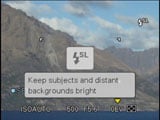 |
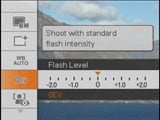 |
The H9 features a built-in flash which pops-up automatically. Pushing the four-way rocker button to the right allows you to cycle between Auto, always on, slow synchro and always off. Pressing the Menu button presents options to adjust the flash level of +/-2EV along with three red-eye options: auto (in conjunction with face detection), always on or always off.
Delving into one of the H9’s Shooting menus allows you to switch from front to rear curtain sync. Like the Olympus SP-550UZ and Panasonic Lumix FZ8, there’s no flash hotshoe on the Sony H9. If you’re after a super-zoom with external flash capabilities, you should consider the Panasonic FZ50.
Sony Cyber-shot DSC-H9 memory, ports and battery
The Sony H9 uses Memory Stick Duo or Pro Duo cards with a slot next to the battery compartment under the body; depending on the size of your tripod this door may or may not be blocked when mounted. Cards up to 8GB have been confirmed to work with the camera.
As usual there’s no card supplied, but Sony’s fitted 31MB of internal memory to get you started. With the H9’s relatively high compression, you’ll actually squeeze about ten to 15 best-quality JPEGs into the internal memory, but you should still obviously start shopping for a separate Memory Stick from day-one. The H9 also lets you copy images from the internal memory to a Memory Stick.
In terms of ports there’s a DC input on the right hand side for an optional AC adapter, while on the bottom left side, you’ll find a proprietary connector for USB and TV output. Sony supplies the H9 with a combined cable ending with a USB plug along with composite video and audio jacks.
Like other models in Sony’s latest Cyber-shot range, the H9 also supports the optional VMC-MHC1 cable which offers Component video output to High Definition TVs to deliver a 1080i signal; this looks great for slideshows and is a highly recommended accessory if you have an HD TV. The H9 is also compatible with Sony’s GPS-CS1KA GPS receiver to tag location details to files.
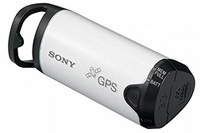 |
The H9’s powered by a relatively small NP-BG1 Lithium Ion battery, rated at 3.4Wh. This is in fact the same battery as used in the Cyber-shot N2 compact, which raises concerns over its suitability for a camera like the H9.
Sony reckons it’s good for 280 shots under CIPA conditions, but in practice with SteadyShot activated and the screen used almost exclusively for composition, we managed nearer 150 shots per charge – and that’s with the focusing set to single mode and the SteadyShot only kicking-in as you half-press the shutter release.
While we don’t begrudge Sony’s decision to fit a big screen and optical stabilisation into a small and light body, there’s no denying the H9 is a camera where you’ll definitely be wanting to carry a spare battery at almost all times.
